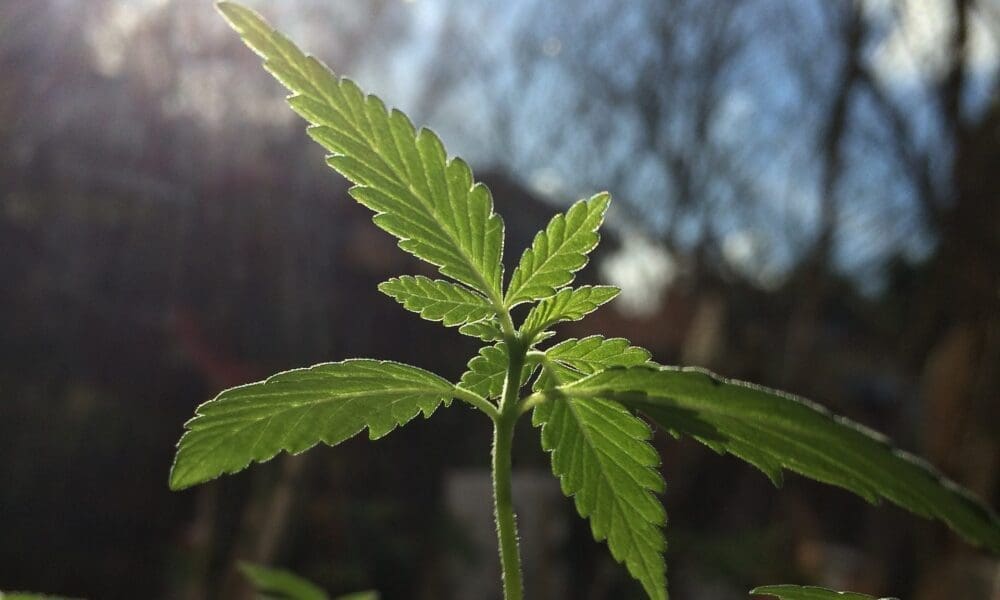featured
Feel the (Cannabis Leaf Margin) Burn
Published
9 hours agoon

It can often be difficult to diagnose cannabis cultivation problems. Just as in humans, a variety of disorders can exhibit similar visual symptoms.
For example, leaf tip burn (also referred to as marginal necrosis) can occur due to a wide range of causes. Here, we explore some of those causes to help cannabis growers diagnose their plant health problems.
High Fertilizer Salts
Salt accumulation leading to high electrical conductivity (EC) is a common cause for leaf margin burn.
Symptoms will generally first appear on the lower foliage as an even marginal burn with increased severity along the leaf margin. Over time, it moves inward to the center of the leaf (Fig. 1).
 Figure 1. Leaf margin burn due to high salt accumulation (elevated EC) on the lower foliage of a cannabis plant. Note the uniform brown necrosis along the leaf edges progressing inward.
Figure 1. Leaf margin burn due to high salt accumulation (elevated EC) on the lower foliage of a cannabis plant. Note the uniform brown necrosis along the leaf edges progressing inward.
There are various ways to confirm high EC problems, including in-house by collecting a solution sample using the PourThru method to evaluate substrate pH and EC using an EC meter. The higher the salt concentration, the greater the electrical reading. Testing substrate EC allows you to understand the total salt concentration of the substrate; however, it does not provide a reading of individual nutrients.
Targeting an EC of 2.0 to 3.0 millisiemens per centimeter (mS/cm) for the Pour Through method or 1.3 to 2.0 mS/cm using the saturated media extract method for vegetative cannabis plants. To avoid high EC from occurring, ensure that you are providing sufficient, but not excessive, fertilizer levels.
For more on EC, see our April 2019 Cultivation Matters column “Optimizing Electrical Conductivity (EC) in Cannabis Cultivation”.
Water Stress
Drought stress is another common cause for leaf margin burn in plants. Similar to high salt accumulation, lower foliage will exhibit more severe visual symptoms compared to upper foliage. Marginal burn will generally be observed following the rehydration of plant tissue and may not be noticed until after the rest of the plant appears healthy.
 Figure 2. Symptoms of drought stress appear as marginal burn on lower leaves following rehydration. Damage is typically more severe on older foliage.
Figure 2. Symptoms of drought stress appear as marginal burn on lower leaves following rehydration. Damage is typically more severe on older foliage.
While there are no easy direct measurements of drought stress occurrence, for most growers, monitoring substrate moisture levels and supplying enough water to promote plant growth without oversaturating the root zone is important. To avoid drought-induced stress, maintain consistent irrigation practices that match the plant’s growth stage and environmental conditions, ensuring even moisture distribution throughout the root zone.
For more on water, see our January 2023 Cultivation Matters column “What’s in Your Water?”
Nutrient Deficiencies
Nutrient deficiencies can also result in leaf margin burning. For example, when potassium (K) is limited, foliar deficiency symptoms will first manifest as a general yellowing of the leaflet margins in lower branches (Fig. 3). If K continues to be limited, this yellowing will continue, resulting in necrotic margins that appear burnt (Fig. 4).
 Figure 3. Initial potassium deficiency symptoms exhibit yellowing (chlorosis) along the leaflet margins of lower leaves in cannabis.
Figure 3. Initial potassium deficiency symptoms exhibit yellowing (chlorosis) along the leaflet margins of lower leaves in cannabis.
 Figure 4. Advanced potassium deficiency symptoms with necrotic (burned) margins following initial yellowing, primarily affecting lower foliage.
Figure 4. Advanced potassium deficiency symptoms with necrotic (burned) margins following initial yellowing, primarily affecting lower foliage.
K deficiency will generally exhibit a slower progression from initial symptoms to leaf margin burn compared to drought stress or high EC, which will exhibit the burn/necrosis faster.
Calcium (Ca) deficiency will also result in marginal burn; however, Ca is an immobile element, and symptoms will first appear in the upper foliage, whereas the symptoms first appear in the lower foliage in K deficiencies. Ca is utilized in cell wall structure, and as a result, when deficient cells are not able to fully expand, it can result in marginal leaf burn and leaf distortion (Fig. 5).
 Figure 5. Calcium deficiency symptoms on upper foliage include marginal burn and distorted leaf growth due to impaired cell wall development.
Figure 5. Calcium deficiency symptoms on upper foliage include marginal burn and distorted leaf growth due to impaired cell wall development.
Ca deficiency can be caused by a lack of transpiration, nutrient imbalance, incomplete fertilizer, or more. Ca is transported via mass flow and requires plant transpiration to be taken up through the xylem. There are a variety of factors that can negatively influence transpiration rate and, as a result, negatively impact Ca uptake, such as low vapor pressure deficit, low airflow, or high temperature.
Additionally, providing the proper balance of K, Ca, and magnesium (Mg) is important for the production of cannabis. Providing too much of one element does not in itself result in toxicity symptoms. Instead, excessive levels of one element can have an antagonistic relationship with the others. For instance, excessive K will result in either a Ca deficiency or an Mg deficiency. In general, a 4:2:1 K-Ca-Mg ratio is recommended to prevent nutrient antagonisms for greenhouse crops.
Conclusion
While symptoms may appear visually similar, careful diagnosis using tools like EC meters and the close monitoring of water, fertility, and environmental conditions is essential for identifying the root cause. Understanding how each factor, such as salts, water availability, and nutrient ratios, impacts plant physiology can help prevent large-scale damage.

Author: mscannabiz.com
MScannaBIZ for all you Mississippi Cannabis News and Information.
You may like
-


ICE Raid Turns Violent at Camarillo Cannabis Farm
-


Massachusetts Cannabis Social Equity Trainings Set to Resume After Year-Long Delay
-


Plague in AZ; Hassayampa River bottom ‘chaos,’ ICE raids cannabis farm | FOX 10’s must-see stories
-


Massachusetts’s Social Equity Cannabis Program Is Back On Track After A Year On Pause
-


Weed near me: How are cannabis shops in Rockland, Westchester faring?
-


Is Cannabis Becoming A Serious Rival To Beer
featured
Massachusetts Cannabis Social Equity Trainings Set to Resume After Year-Long Delay
Published
15 minutes agoon
July 14, 2025
The Massachusetts Cannabis Control Commission (CCC) plans to resume the state’s cannabis social equity training program this fall after a year-long delay caused by budget constraints, the CommonWealth Beacon reports.
Regulators approved 229 individuals for the trainings last year, but the process halted abruptly after the Legislature failed to allocate proper funding. State officials now plan to resume the program for the approved applicants on September 8 and will begin accepting additional applicants starting August 1.
Passed by voters in 2016, the state’s cannabis legalization law requires a social equity program that includes cannabis industry trainings, guidance for navigating the industry’s many regulatory hurdles, networking opportunities for approved applicants, and fee waivers to help cannabis business owners or employees enter the industry, the report said.
The CCC’s Acting Chair Bruce Stebbins told the Beacon that he appreciated officials’ efforts to carry on the program despite funding-related uncertainties.
Kevin Gilnack, the deputy director of Equitable Opportunities Now, said in the report that while he appreciates the difficulties faced by regulators, “it’s definitely frustrating to those who were really eager to get into the industry and looking at this [training program] as their pathway into it.”
“I think the important thing is that we figure out a way to make sure that future social equity program participants aren’t held back by these funding challenges. It would be great to see the Legislature actually set up automatic funding so that regardless of what else is going on, social equity will remain a priority that actually gets fulfilled every year.” — Gilnack, to the Beacon
Meanwhile, Gov. Maura Healey (D) last year awarded 50 grants totaling $2,350,000 to cannabis social equity businesses through the state’s Cannabis Social Equity Trust Fund.

Author: mscannabiz.com
MScannaBIZ for all you Mississippi Cannabis News and Information.
featured
Massachusetts’s Social Equity Cannabis Program Is Back On Track After A Year On Pause
Published
1 hour agoon
July 14, 2025
“It’s definitely frustrating to those who were really eager to get into the industry and looking at this as their pathway into it.”
By Bhaamati Borkhetaria, CommonWealth Beacon
The Massachusetts Cannabis Control Commission’s (CCC) social equity program—which has been on pause for a year due to budget constraints—is back on track for the fall.
Last year, the commission accepted 229 individuals into the cannabis industry training program for individuals most impacted by the war on drugs, but said that the agency didn’t have funding from the Legislature to operate the program as promised. The course is aimed at providing industry training, technical assistance around regulatory requirements, networking opportunities and fee waivers for those impacted groups to make it easier for them to enter the industry as cannabis business owners or employees.
Now, with pressure from advocates to get the program restarted, CCC leadership says it is now kicking off on September 8 with the current round of applicants and will accept more applicants starting August 1.
The Legislature capped the agency’s budget at $19.88 million—about $10 million less than the commission’s $30 million budget ask for fiscal year 2026. This kicked off a back-and-forth between the commission’s leadership and lawmakers over whether the CCC is adequately funded to complete crucial IT infrastructure updates, hire for important positions and conduct public awareness campaigns.
Bruce Stebbins, the commission’s acting chair, said to CommonWealth Beacon after the commission’s public meeting on Thursday that he is excited for the social equity programming to begin again and that he is appreciative of the agency’s staff for working within the current budget to keep the process moving along.
“They’ve understood the constraints of the level [of] funding that we’ve gotten over the last couple of years, and I think they’ve pivoted effectively,” said Stebbins. “They’re trying to make changes so that the program remains open to everybody and everybody has access to the program material.”
The cohort that was accepted last summer was given access to virtual training on an online platform called TalentLMS, but didn’t receive the in-person instruction and networking opportunities that previous cohorts did. Starting in September, there will be updated courses on the platform and trainings offered through Zoom. The classes will be virtual in order to limit costs.
Many accepted individuals have been waiting for the programming to begin in earnest for over a year, expressing open disappointment with the delays.
“I understand the tensions around the budget and the fact that the Legislature has kept the commission on a pretty tight string, and that the commission has had to make tough choices, but it’s definitely frustrating to those who were really eager to get into the industry and looking at this as their pathway into it,” said Kevin Gilnack, deputy director of the cannabis advocacy group Equitable Opportunities Now, who was one of the applicants accepted in last year’s cohort.
Gilnack—who was once arrested for cannabis possession—said he is eager to take the business- and cannabis industry-specific classes offered by the program, so he can figure out if there is a viable path for him to enter the competitive industry.
Part of the pitch in the successful 2016 ballot measure for cannabis legalization in Massachusetts included assisting those harmed by the war on drugs to participate in the legal industry. The subsequent law legalizing cannabis and creating the CCC, passed by the Legislature in 2017, directs the commission to ensure full participation—still a somewhat ambiguous metric—in the industry by those disproportionately harmed by marijuana prohibition.
The commission often touts its work as a nationwide model, in part because of its social equity training program.
But the funding issues are not likely to resolve soon. Lawmakers have kept a critical eye on the turmoil and regulatory delays at the commission in the past two years. Issues include allegations of bullying at the agency, failure by the commission to collect over $500,000 in licensing fees and long delays in major regulatory changes. The House passed a cannabis reform bill on June 4 that would restructure the commission to a three-member body appointed solely by the governor as a way of addressing some of the agency’s leadership issues.
Gilnack’s group is advocating for a bill put forward by state Sen. Liz Miranda (D) of Boston, who co-chairs the Joint Committee on Racial Equity, Civil Rights and Inclusion. The bill would automatically set aside funding from cannabis tax revenue to go towards the social equity program, even if the Legislature chooses not to fully fund the commission through its ordinary process and without considering how the commission chooses to allocate its budget.
“I think the important thing is that we figure out a way to make sure that future social equity program participants aren’t held back by these funding challenges,” said Gilnack. “It would be great to see the Legislature actually set up automatic funding so that regardless of what else is going on, social equity will remain a priority that actually gets fulfilled every year.”
This article first appeared on CommonWealth Beacon and is republished here under a Creative Commons Attribution-NoDerivatives 4.0 International License.![]()

Author: mscannabiz.com
MScannaBIZ for all you Mississippi Cannabis News and Information.

The ground is shifting under the beer industry – and marijuana is a reason
Beer is the third most popular drink globally behind water and tea. But in the US, is cannabis becoming a serious rival to beer? According to recent research from investment bank TD Cowen, U.S. cannabis sales reached $29 billion in 2023, up from approximately $10 billion just five years earlier. That figure now represents about 11 percent of the total U.S. alcohol market, up from just 4 percent in 2018. Cannabis sales are projected to reach $37 billion by 2027, driven by increased legalization and changing social attitudes.
RELATED: The Connection Between Country Music And Cannabis
TD Cowen, which covers alcohol and cannabis as part of their portfolio, forecasts the number of monthly cannabis users will grow by 18 million in the next five years, while alcohol is expected to lose about 2 million regular consumers. They also forecast the number of monthly cannabis users will grow by 18 million in the next five years, while alcohol is expected to lose about 2 million regular consumers.

Independent reporting from the Financial Times supports this trend. In states where cannabis is legal, two-thirds of cannabis users reported drinking less alcohol, with beer the most affected category. A similar trend has been observed in Canada, where beer sales per capita dropped more than 2 percent annually following national legalization.
Some alcohol industry analysts are sounding the alarm. A Forbes article earlier this month linked the underperformance of alcohol stocks to growing health-conscious behaviors and increased cannabis use, particularly among younger adults seeking alternatives to traditional drinking.
Despite the shift in spending, beer remains a staple for many consumers. A recent analysis by YouGov and Google Trends reveals that Miller is the most popular beer in 30 states, including the Midwest and Southeast. Coors leads in eight states, including California, Texas, and Arizona, while Guinness is most searched in New Jersey, Georgia, and South Carolina. Also, still maintaining strong sales are Budweiser, Bud Light, Blue Moon, and Corona, although each holds a smaller share of state-level popularity.
RELATED: Cannabis Is Way Better And Safer Than A Honey Pack
This evolving consumer landscape suggests a long-term rebalancing of the alcohol and cannabis markets. Much of the shift is driven by younger Millennials and Gen Z, who increasingly prioritize wellness, moderation, and cannabis as a social alternative to alcohol. Industry watchers say beer companies may need to adjust—either by diversifying into cannabis-infused beverages or rethinking how they market to health-conscious consumers.
As more states move toward legalization and public sentiment shifts, the once-clear lines between the cannabis and alcohol industries are beginning to blur. Whether beer can hold its ground or cannabis continues to climb remains to be seen—but the competition is clearly underway.

Author: mscannabiz.com
MScannaBIZ for all you Mississippi Cannabis News and Information.

ICE Raid Turns Violent at Camarillo Cannabis Farm

Massachusetts Cannabis Social Equity Trainings Set to Resume After Year-Long Delay

Plague in AZ; Hassayampa River bottom ‘chaos,’ ICE raids cannabis farm | FOX 10’s must-see stories

Massachusetts’s Social Equity Cannabis Program Is Back On Track After A Year On Pause

Weed near me: How are cannabis shops in Rockland, Westchester faring?

Is Cannabis Becoming A Serious Rival To Beer

Federal Agency Cancels Marijuana Production Deal With University Of Mississippi, Ending Partnership That Lasted Half A Century

HYTN Secures Cannabis Drug License, Advancing Pathway for Prescription Cannabinoid-Based Medicines

What Happens After Adult-Use Legalization? Uruguay’s 10-Year Cannabis Report Card

Pew Poll: Few Americans Support Feds’ Blanket Prohibition of Marijuana

Worker Killed, Hundreds Arrested During ICE Raids on California Cannabis Farms

Taylor Police Department working to remove unauthorized marijuana content posted to Google page

The recreational use of marijuana on tribal lands in Mississippi could be legalized in near future

New Bipartisan Marijuana Legalization Bill In Pennsylvania House Comes As Separate Senate Proposal Gains Momentum

Federal authorities arrest 319 illegal aliens in major ICE raid at Cali cannabis farm

Feel the (Cannabis Leaf Margin) Burn

WATCH: Seized marijuana destroyed | The Manila Times

THE SUPER GROW ROOM (1983)

Day after federal immigration raid at Glass House Farms in Camarillo, family members search for missing loved ones

Senate Committee Voices Concern About ‘Misleading’ Cannabis Marketing And Promotes Psychedelics Research After Passing Hemp Ban

Federal officials announce 200 workers arrested in Carpinteria, Camarillo farm raids

New details revealed about suspects arrested during ICE raid at Cannabis farm

White House cannabis rescheduling meeting (Newsletter: July 14, 2025)

361 arrested in immigration sweeps at 2 Southern California cannabis farms, feds say

Alert: Department of Cannabis Control updates data dashboards with full data for 2023

Connecticut Appoints The US’s First Cannabis Ombudsperson – Yes there is a pun in there and I’m Sure Erin Kirk Is Going To Hear It More Than Once!

5 best CBD creams of 2024 by Leafly

Free delta-9 gummies from Bay Smokes

EU initiative begins bid to open access to psychedelic therapies
New Study Analyzes the Effects of THCV, CBD on Weight Loss

Mississippi city official pleads guilty to selling fake CBD products

May 2024 Leafly HighLight: Pink Runtz strain

Curaleaf Start Process Of Getting Their Claws Into The UK’s National Health System – With Former MP (Resigned Today 30/5/24) As The Front Man

5 best autoflower seed banks of 2024 by Leafly

Horn Lake denies cannabis dispensary request to allow sale of drug paraphernalia and Sunday sales | News

Discover New York’s dankest cannabis brands [September 2024]

Press Release: CANNRA Calls for Farm Bill to Clarify Existing State Authority to Regulate Hemp Products

Local medical cannabis dispensary reacts to MSDH pulling Rapid Analytics License – WLBT

Nevada CCB to Accept Applications for Cannabis Establishments in White Pine County – “Only one cultivation and one production license will be awarded in White Pine County”

5 best THC drinks of 2024 by Leafly

6 best CBD gummies of 2024 by Leafly

The Daily Hit: October 2, 2024

5 best delta-9 THC gummies of 2024 by Leafly

Weekly Update: Monday, May 13, 2024 including, New Guide for Renewals & May Board meeting application deadline

People In This State Googled ‘Medical Marijuana’ The Most, Study Shows

Thailand: Pro-cannabis advocates rally ahead of the government’s plan to recriminalize the plant

PRESS RELEASE : Justice Department Submits Proposed Regulation to Reschedule Marijuana

Press Release: May 9, STIIIZY and Healing Urban Barrios hosted an Expungement Clinic & Second Chance Resource Fair
Trending
-

 California Cannabis Updates1 year ago
California Cannabis Updates1 year agoAlert: Department of Cannabis Control updates data dashboards with full data for 2023
-

 Breaking News1 year ago
Breaking News1 year agoConnecticut Appoints The US’s First Cannabis Ombudsperson – Yes there is a pun in there and I’m Sure Erin Kirk Is Going To Hear It More Than Once!
-

 best list12 months ago
best list12 months ago5 best CBD creams of 2024 by Leafly
-

 Bay Smokes1 year ago
Bay Smokes1 year agoFree delta-9 gummies from Bay Smokes
-

 Business10 months ago
Business10 months agoEU initiative begins bid to open access to psychedelic therapies
-

 cbd1 year ago
cbd1 year agoNew Study Analyzes the Effects of THCV, CBD on Weight Loss
-

 Mississippi Cannabis News1 year ago
Mississippi Cannabis News1 year agoMississippi city official pleads guilty to selling fake CBD products
-

 California1 year ago
California1 year agoMay 2024 Leafly HighLight: Pink Runtz strain



